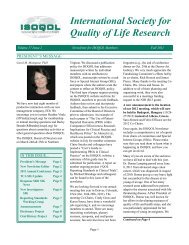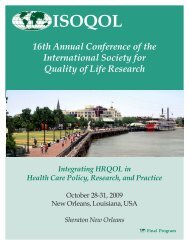Conference Program (PDF) - ISOQOL
Conference Program (PDF) - ISOQOL
Conference Program (PDF) - ISOQOL
Create successful ePaper yourself
Turn your PDF publications into a flip-book with our unique Google optimized e-Paper software.
Workshop 6 will not be presented<br />
Wednesday - Workshops<br />
Workshop 7<br />
St. James Room<br />
Advanced Psychometric Methods, Part 1: Use of Exploratory and Confirmatory Factor Analyses in<br />
PRO Instrument Development and Evaluation<br />
Instructors: Donald Stull, PhD, United BioSource Corporation, Bethesda, MD, USA; Margaret Vernon,<br />
PhD, United BioSource Corporation, Bethesda, MD, USA; Elizabeth Merikle, PhD, United BioSource Corporation,<br />
Bethesda, MD, USA<br />
The development and psychometric evaluation of PRO instruments requires the application of a number of different techniques,<br />
including exploratory and confirmatory factor analysis (FA), and structural equation modeling (SEM). We will provide a brief<br />
overview of psychometric analyses and will then focus on the application of (1) exploratory and confirmatory factor analysis for<br />
understanding of new measures and (2) use of SEM for testing construct validity. Exploratory and confirmatory FA can be used<br />
to examine the relationships among items with a PRO measure or among different domains or multiple PRO measures. These<br />
techniques are useful for understanding the internal structure of PRO instruments and for understanding construct validity. This<br />
half-day workshop will describe the main methods of FA and illustrate these methods with examples from the instrument<br />
development literature. SEM is a powerful analytic technique that combines FA and path analysis in a simultaneous, confirmatory<br />
approach. Using SEM, the researcher can specify and evaluate hypothesized relationships between observed and latent (unobserved)<br />
constructs as well as relationships among the latent variables. SEM can also estimate the reliability and validity of<br />
measurement models while explicitly modeling measurement error. A researcher specifies a measurement model and a structural<br />
model which specifies relationships among the latent variables to examine construct and criterion-related validity. If the<br />
observed covariances are consistent with the model-implied covariances, the researcher has evidence supporting the construct<br />
validity of the PRO measure. This workshop will demonstrate the main methods, testing assumptions and criteria, and provide<br />
examples to illustrate the methods of SEM. Level: Advanced<br />
Workshop 8<br />
Cadogan Room<br />
How many subjects do I need for my study? Sample size determination for studies with QoL outcomes<br />
Instructor: Stephen Walters, PhD, University of Sheffield, Sheffield, UK<br />
Quality of Life measures are now frequently used in clinical trials and health services research, as primary endpoints. Thus<br />
investigators are now wanting to plan studies using QoL measures, which includes questions on sample size. Sample size<br />
calculations are now mandatory for many research protocols and are required to justify the size of studies in papers before they<br />
will be accepted by journals. Sample size is critically dependent on the purpose of the study, the QoL outcome measure and how<br />
it is summarised, the proposed effect size and the method of calculating the test statistic. Whatever type of study design is used<br />
the problem of sample size must be faced. This workshop will describe how sample sizes may be estimated for a variety of<br />
different study designs using QoL outcomes. The study designs will include: two group clinical trials, cross-over trials, crosssectional<br />
surveys and reliability studies. The consequences of comparing more than two groups or investigating several QoL<br />
outcomes simultaneously are discussed. This course will provide practical guidance on the estimation of sample size for a<br />
variety of study designs. It will feature many real and original examples, taken from the instructor’s experience of analysing<br />
PROs. Content: Introduction to significance tests, P-values and power; Samples sizes for comparison of two independent<br />
groups; Sample sizes for paired designs; Sample sizes for equivalence/non-inferiority studies; Unequal groups; Multiple comparisons;<br />
Sample sizes for surveys; Sample sizes for reliability and method comparison studies; Use of computer simulation. It<br />
is expected that course participants will be familiar with statistical concepts such as: hypothesis testing; confidence intervals;<br />
simple statistical tests (e.g. t-test). Level: Basic<br />
12:00-1:00 pm<br />
Lunch on your own<br />
1:00-4:00pm<br />
Afternoon Workshops<br />
Workshop 9<br />
Waterloo/Tower Room<br />
Everything you wanted to know about modern psychometric methods but were too afraid to ask:<br />
Part 2<br />
Instructors: Jeremy Hobart, MD PhD, Peninsula Medical School, Plymouth, Devon, UK and Stefan Cano,<br />
PhD, Peninsula Medical School, Plymouth, Devon, UK<br />
Part 2 builds on Part 1 and is a direct response to last year’s feedback for more time in general, more detail on the similarities<br />
and differences between Rasch measurement and IRT, more examples of practical applications and their interpretation, and the<br />
call for whole day devoted to this critically important topic. This allows the workshop to develop further the ideas behind modern<br />
psychometric methods a little deeper but still in a non-technical and basic manner. We will provide multiple examples of the<br />
applications of Rasch measurement to scale evaluation, scale modification, new scale development, head to head scale comparisons,<br />
item banking, and the all important issue of determining clinically significant change. Level: Basic<br />
11







